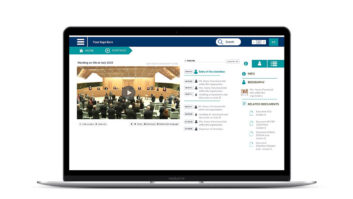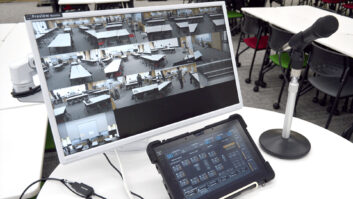The MasterFormat Expansion Forum
Jun 1, 2002 12:00 PM,
Michael D. Chambers
THE MASTERFORMAT EXPANSION Forum presented at NSCA’s Expo 2002 discussed the proposed expansion of the Construction Specifications Institute’s MasterFormat and its impact on NSCA members. Beyond that, the program also discussed how to be effective in implementing the proposed expansion areas. This article will present a brief overview of the future of technology and design, suggested strategies about maximizing relationships with design professionals and being effective consultants and integrators.
THE FUTURE OF TECHNOLOGY AND DESIGN
- Design-Build. One of the fastest growing segments of the construction industry is design-build. From the technology integration point-of-view, several key issues must be considered in the design-build process. In marketing to design-builders, relationship selling is paramount. It is important to develop relationships with both the designer and builders in the team. Although cost is always an issue, more often than not, timing becomes more important (time is money, after all). The ability to deliver products or systems on time is critical. For a manufacturer or distributor, understanding subcontractor relationships and preferences can be a significant competitive advantage.
- Performance Specifications. There appears to be an increase in the use of performance specifications in the construction industry. The reasons are usually a client’s lacking knowledge about systems and products or a manufacturer’s jockeying to protect a sole-source specification. Enforceable performance specifications for a building or any element of a building must begin with the identification of basic requirements. Performance specifying has commonly been limited to a few types of products rather than building elements, so specifiers, architects and engineers have not had much experience with the process of identifying requirements. Consultants and integrators must learn and understand the ramifications of using performance criteria in specifications. True performance specifications allow integrators to develop systems rather than obtain a competitive product advantage.
- Strategy vs. Tactics. As the integration of technology into building design increases, it is important to develop a strategy to bring technology to the attention of the design community in the initial phases of the design process. A strategy is a big-picture, visionary notion that considers what needs to be accomplished, who the key players are, and how the process should happen. Tactics are the tools or methods used to accomplish the strategic objectives.
Too often, consultants and integrators focus on tactics of products, systems and design while ignoring the larger strategic issues of identifying problems and justifying the role of technology integration in the design process. Technocrats are always far more comfortable with methods, materials and tools. Owners and designers need to understand the larger picture and the critical benefits of integrating technology into the building design rather than the current alternation and renovation of technology into brand new buildings.
Integrators and consultants have two powerful strategies for working effectively with design professionals in the design process. Continuing education helps elevate the role of the consultant from vendor to design partner. A knowledgeable design professional asks better questions and becomes a powerful ally in developing an appropriate system. The ability to work closely with design professionals in developing specifications is a huge competitive advantage. Specification strategy is about getting the products and systems specified appropriately and competitively. An integrator can reduce noncompetitive substitutions and inappropriate systems or products by helping the specifiers craft competitive specifications.
HOW TO BE EFFECTIVE WITH DESIGN PROFESSIONALS
- Relationship. Developing good working relationships is the most effective way to develop strong system/product identifications. Understanding what design professionals do is critical to forming positive relationships with them. Asking questions rather than talking or lecturing can make all the difference. Listening is the most powerful sales tool of all.Another powerful way to establish relationships with design professionals is to become an educator. Education is the best tool for influencing design and getting specified. Educating design professionals establishes solid professional credibility and removes the stigma of being a vendor. The better an educator you are, the better your relationships to designers and the better your chances of being included in a project.
- Effective Marketing Calls. In a survey done by McGraw-Hill, design professionals were asked what they wanted from product representatives. The top two results were:The bottom choice was “Manufacturer’s history, experience overall capacities and range of products” at just 40 percent. That means that design professionals want to know how to appropriately apply and integrate products into their designs. They do not want to be bombarded (and confused) by competitive features and benefits. The need for guide specifications clearly indicates the need to write clear, competitive and enforceable specifications. The last thing design professionals want to know are all the facts about your company.Once again, a critical element for effective architectural sales calls is the ability to listen. Practically every time a rep calls, the first words spoken are always about company history, the president’s ancestors and how many products have been installed. Next comes how many years they have been in the business, how big their territory is and so on. Then comes a guided tour through the product binder, page by painstaking page. In all this time, the rep has never once asked about projects and how products are selected. They hardly ever ask if the office master specifications are up-to-date. That’s why the best advice for effective architectural sales calls is to shut up and listen, to put it bluntly. Reps should ask questions that will allow the potential customer to speak extensively about their projects and procedures. Architects and engineers have amazing knowledge and insights that can be discovered by those who will listen.The easiest way to develop a competitive advantage with design professionals is to focus on use and application, product limitations and industry knowledge.
- Recommended uses and application of products (92 percent)
- Guide specifications (88 percent)
- Specifications as Marketing Tools. Although it may go against the grain of every salesperson’s basic instinct, competitive specifications typically offer the best results for increasing sales and creating successful designs. When a spec is based on clear industry standards and qualified manufacturers, everyone benefits. The owner gets the best price, the design professional’s intent remains intact and the industry competitors have a level playing field. Anytime sole-source or noncompetitive specifications are employed, substitutions are unavoidable.Substitutions are the last thing reps and design professionals want to deal with. For the design professional, substitutions mean significant extra work, usually at the last minute, requiring decisions based on inadequate information and sales pitches. For the product rep, substitutions mean struggling for last-minute access to the specifier and typically competing on price alone rather than best application and support of the design intent. It is rare for a general contractor to consider a substitution unless offered a cost advantage. Of course, pre-bid substitutions are somewhat different, but the same principles apply.The best way to eliminate substitutions is to ensure that every appropriate manufacturer (even competing ones) is included in the specification. That requires that the reps be knowledgeable about the competition and that the design professionals understand how the industry works. Furthermore, don’t wait until the last minute to get products to the design professional.
- Continuing Education. Product reps must become educators to be most effective with design professionals. Learn how to educate design professionals using continuing education opportunities. Even in education relationships are key. Successful education presentations are based on face-to-face exchange of knowledge, not PowerPoint slides or slick videos. Successful educational experiences stem from the rep’s ability to communicate his or her industry expertise and willingness to make it available as a design and specification resource. Reps and their manufacturers have a responsibility to educate design professionals about the realities of the industry and how to reflect that reality in their specifications. In an educational context, remember to be an educator, not a salesperson.
- Using the Internet. A Web site is not an electronic catalog. It is a database of knowledge about industry practice, standards, expertise, products and product use. The ability to combine graphics, technical data and specifications in an easy-to-use format is the most effective marketing use of the Internet. A Web site should contain everything necessary to understand, design and specify a standard application of the product or assembly. Web sites that focus on features and benefits and competitive disinformation rarely get return visits.Colin Gilboy, president and Webmaster of 4specs.com says, “Your Web site should provide the information a designer needs to select and design using your products. Don’t worry about your competitors. They already have your UL test reports and other proprietary information, so make that information available to the architect. You have copies of their information, don’t you? Make it easy for potential users to access the information.” If a specifier leaves your Web site for another and finds a critical piece of information there — especially information that you could have provided — then your site has failed.
- Networking: Professional and Industry Associations. Being active in CSI, The American Institute of Architects (AIA) and other design-industry associations increases the opportunities for relationships. Although the current trend suggests that investing time in associations is a low priority, the advent of continuing education and the crucial need to be specified to increase sales should cause everyone to reassess active membership in industry associations. Actively participating in industry associations can have a positive impact on both sides of the relationship. Generally, product reps who are active members of industry associations are always more sophisticated and knowledgeable about industry trends and processes. The critical element here is industry expertise and how to communicate it. Industry associations as networks and providers of education are a good resource for design professionals and product reps alike.
Thinking strategically and focusing on relationships with design professionals can have a positive effect on any industry member’s bottom line by helping to get products specified and establishing a competitive advantage. The proposed MasterFormat Expansion is a significant opportunity for NSCA members to expand their critical marketing networks to include design professionals.
Michael D. Chambers, FAIA, FCSI, CCS serves the construction product industry by teaching strategies and tactics to reach design professionals and get products specified. Chambers is a Fellow of AIA and CSI and is also active in SCIP, NSCA, WDMA and DHI. He is principal of MCA Specifications, Eden Prairie, Minnesota, and is a specifier with ATS&R Architects of Minneapolis.






